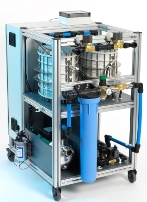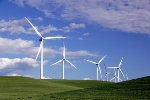
Obama administration announces plans to install new solar panels on the White House residence.

Faster development of the promising field of cellulosic biofuels -- the renewable energy produced from grasses and trees -- is being significantly hampered by a "deep and thorny regulatory thicket" that makes almost impossible the use of advanced gene modification methods, researchers say.

This is the second installment of a multi-part series on some of today's problems in land development and how innovative methods collectively known as "Prefurbia" can help overcome them.

The “Design for Reuse Primer,” a free e-book, looks at the untapped potential of material reuse through the perspectives of the architects, contractors, and clients committed to its use.

An Oceana analysis shows that offshore wind potential is so high off the U.S. Atlantic coast that investments in offshore wind power in Atlantic waters could generate about 30 percent more electricity than economically recoverable offshore oil and gas in the same region combined.
A U.S. Department of Agriculture study has developed a formaldehyde-free glue for wood applications.
The International City/County Management Association found that while local governments recognized the need to create sustainability, they generally have not been able to act on that knowledge.
Advanced tracking software and ISO standard procedures improve performance and provide assurance for responsible recycling.

By observing cloud shape, size and movement, the system provides a way for utility companies to predict and prepare for fluctuations in power output due to changes in weather.
Nearly 1 million charging stations are expected to be installed across the United States; activity is already starting with collaborations and investment across the country.

The Anglo-Dutch company has based its technology on oppositely charged electrodes combined with anionic and cationic selective membranes.

Researchers at Rensselaer Polytechnic Institute are leading a new $2 million study to help overcome a key bottleneck slowing the proliferation of large-scale wind and solar power generation.

This is the third year that the Students and Young Professionals Committee has managed a project in the cities that have hosted the annual conference. This year's project is called "Bioswales in the Bayou" and is designed to stem stormwater flooding in the Ninth Ward.
The Office of Naval Research has designed a system that controls electrical flow for lighting, a highly efficient platform that may spark a new era of power savings.

The researchers' custom-built processing machine uses an innovative process with relatively low temperatures in a fluidized bed of sand and salts to economically produce biomass fuel from sludge.
Water-gel-based solar devices -- artificial leaves -- can act like solar cells to produce electricity.
The city of Cleveland's mayor is one of more than 1,000 mayors who have signed an agreement to lower carbon dioxide emissions by 7 percent by 2012.
Cyclone Power Technologies' WHE/Generation system converts waste heat to mechanical power and electricity.
Photographing glaciers, valuing natural ecosystems, and establishing a seed vault are a few of the innovations created by this year's Heinz Family Foundation awardees.